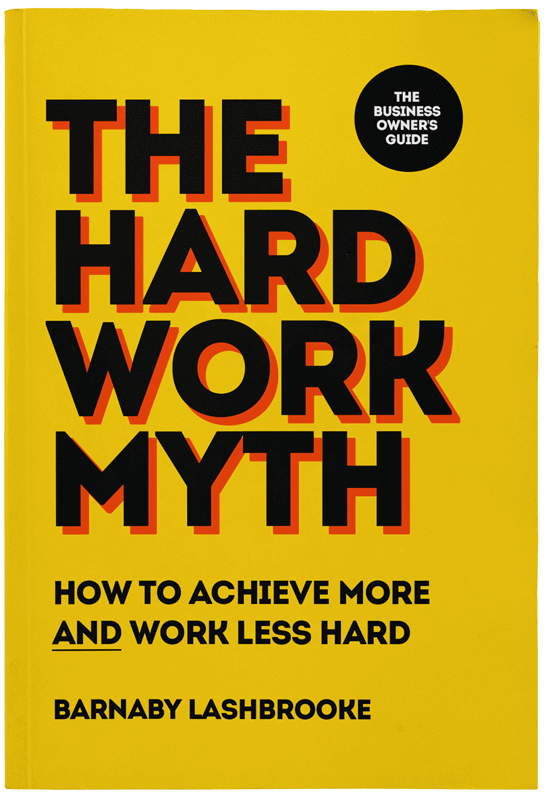There's a critical task sitting on your plate. Maybe it's reviewing that financial report, updating your website, or finally scheduling those client follow-ups. You know it needs to get done. You want to get it done. But somehow, you find yourself reorganizing your desktop icons, scrolling through emails you've already read, or suddenly deciding that now is the perfect time to deep-clean your keyboard.
If this sounds familiar, you're not alone. Around 20% of adults identify as chronic procrastinators, but for founders and small business owners, the stakes run even higher. When everything rests on your shoulders, every delayed decision or postponed task can ripple through your business. And over time, that constant stress of “catching up” can wear you down, both mentally and physically.
But here's what most productivity advice gets wrong: procrastination isn't a time management issue.
Dr. Tim Pychyl, author of Solving the Procrastination Puzzle and former psychology professor at Carleton University, defines procrastination as "a purely visceral, emotional reaction to something we don't want to do."
This is pretty good news, because it means we can address the real cause instead of just fighting the symptoms.
Dr. Pychyl found that procrastination can usually be traced back to one of eight emotional triggers, so let's take a closer look at each of them...
1. Boredom
We've all been there. You need to update your expense spreadsheet, process invoices, or enter data into your CRM. You tell yourself you’ll “get to it later,” but hours, days, even weeks pass, and it's still not ticked off your to-do list. It's not a lack of time or a lack of skill that's the problem. It's just painfully boring.
When a task feels dull or repetitive, it fails to engage your brain's reward system. Your brain craves stimulation and novelty, so when faced with monotonous work, it naturally gravitates toward more interesting alternatives. That's why you suddenly find yourself checking social media or reading articles about things you don't actually care about.
How to beat boredom and stay focused
The key is to make it feel less like a chore and more like a mini challenge or game. A little friendly competition with yourself can go a long way.
Speed-run and score it: Set a 10-minute timer and challenge yourself to produce a "worst acceptable version" as fast as possible. Give yourself one point per completed micro-move. Opening the spreadsheet equals one point. Filling five rows equals another point. Aim for seven points before the timer ends.
This technique works because it transforms a mundane task into a game with clear rules and immediate feedback. Your brain gets the novelty and challenge it craves, making it easier to push through the boredom. Plus, you'll often find that once you've completed your "worst acceptable version," you've built enough momentum to keep going or at least made substantial progress.

2. Frustration
You're trying to generate a report from your business software, but the interface is confusing. The export button is hidden somewhere in a nested menu. The data doesn't format correctly. You've wasted 15 minutes just trying to figure out where to click, and now you're irritated.
Frustration is a powerful trigger for procrastination. Things like clunky systems, vague instructions, or inefficient processes create negative emotions that your brain wants to escape. And since no one likes feeling stuck, avoidance becomes the path of least resistance.
How to fix frustration and get back on track
When you notice frustration building, you need a circuit breaker.
S.T.O.P. and Next Obvious Step: Stop what you're doing. Take two slow box-breaths: inhale for four counts, hold for four, exhale for four, hold for four. Observe where you're stuck and describe the exact issue in one sentence. Then proceed with the Next Obvious Step you can complete in two minutes or less.
Your next obvious step might be: re-read the last paragraph of the instructions, isolate the specific error message you're getting, or paste the exact problem into a note so you can ask for help later.
This technique works because it helps you pause the emotional spiral and switch into problem-solving mode. Taking a few deep breaths settles your nervous system, and choosing one small, specific action gives you something clear to focus on, so instead of feeling buried by the whole mess, you know exactly what to do next.
3. Difficulty
As a founder, chances are you're constantly facing tasks that push you out of your comfort zone. When things start to get difficult, it creates a kind of mental resistance. That fear of not being capable enough, or of wasting time and energy on something that you might mess up, can be paralyzing.
Instead of facing that discomfort, we look for quick relief. We scroll, tidy up, answer an email—anything that feels productive but helps us avoid feeling stuck in the tough stuff. It’s a trade-off our brains make all the time: a moment of comfort now, at the cost of progress later.
But the thing is, most of the time, the task isn’t actually as impossible as it seems. We inflate it in our minds, turning it into something bigger and scarier than it really is. Once you finally dive in, you usually realize it’s far more doable than you thought.
How to make things simpler to stay in the zone
The solution is to break down the difficulty and shrink the task to something manageable.
Use the 'Feynman technique': Explain the task in plain language as if you were teaching it to someone with zero background knowledge. As you explain, underline what you don't actually understand. This exposes the gaps in your knowledge and often reveals that the task isn't as overwhelmingly difficult as you thought. You just need clarity on a few specific points.
Shrink the task to a starter step: Write down one action you can finish in five minutes or less that moves the task forward. Do only that. Nothing more.
For example, if you need to create a marketing strategy, your starter step might be: "List three competitors and visit their websites." That's it. Once you complete that micro-action, you've built momentum and reduced the psychological barrier of starting.
See: How To Overcome Productivity Paralysis When Starting Work Is A Struggle

4. Stress
Unfortunately, running a business naturally comes with a lot of stress. You’re balancing client needs, managing your team, keeping an eye on finances, making big strategic calls—and all the rest! When that stress peaks, your brain loses some of its cognitive flexibility, making it harder to think clearly, focus, or plan your next move effectively.
When we're stressed about getting things done, we often respond by avoiding the very tasks causing our stress. It's a vicious cycle. We procrastinate because we're stressed, which creates more stress, which leads to more procrastination.
How to stop stress from sabotaging your progress
You need to take what’s swirling around in your head and get it out where you can see it. Then, you can start to take action.
Dump-Select-Block (3×3): First, do a one-minute brain-dump of every worry and unfinished task that's looming over you. Get it all on paper. Second, circle up to three items that actually matter today, limiting each to 15 minutes or less. Third, schedule three focused 25-minute work blocks (with 5-minute breaks) for those items.
This technique is powerful because it transforms an overwhelming mental load into a concrete, manageable plan. You're trying to do three things. That's achievable, even on a stressful day.
Use a "good-enough" checklist: Redefine what "done" means. For example, done equals submitted draft, not perfect. Done equals decision made, not optimal outcome. When stress is high, perfect is the enemy of done. Give yourself permission to be good enough.
See: 10 Unconventional Stress-Relief Hacks Every Business Owner Should Try
5. Ambiguity
Have you ever received a vague request like "put together something for the board meeting" or "improve our customer experience"? When you’re not sure what’s actually being asked—or how to tackle it—your brain treats that uncertainty as a threat. Without clarity, you hit mental resistance and start putting it off until you can “figure it out.”
The problem is, that figuring-it-out phase can drag on forever, especially when you’re already juggling a dozen other priorities.
How to restore clarity so you can finally get started
Clarity comes from defining exactly what you’re aiming for and asking the right questions to get there.
Define "Done": Write a one-sentence definition of what done looks like. Include what the outcome should be, who it's for, and the deadline or checkpoint. For example: "Done equals a one-page summary for Alex, with three options and a recommendation, by 3 pm."
This small shift turns something vague into something tangible. Now you know exactly what you’re working toward, and that makes getting started so much easier.
Ask clarifying questions: List your top three questions blocking progress. Answer what you can on your own. For the rest, send a brief message to the relevant stakeholder with those three questions. Don't overthink it. Just ask.
Most people procrastinate on asking for clarification because they worry about looking incompetent. Here's the truth: asking smart questions makes you look competent and saves everyone time in the long run.

6. Unstructured tasks
Some tasks come with built-in structure. Filing taxes has clear forms and steps, for instance. But when you're running a business, much of your work might be open-ended: "develop our content strategy," "improve team morale," or "explore new revenue streams."
Without clear steps or workflows, it’s hard to know where to begin, so you don't begin at all. The blank page is terrifying.
How to stop messy tasks from slowing your momentum
Create structure where none exists.
Five-step checklist: Use a simple framework: Collect → Outline → Draft → Review → Submit. Rename these steps as needed for your specific task, but keep the basic structure. Add a concrete deliverable to each box.
If you're developing a content strategy, your steps might look like:
- Collect = List 10 competitor content examples and five customer pain points
- Outline = Eight bullet points covering channels, frequency, and topics
- Draft = Three-page document with examples
- Review = Get feedback from one team member
- Submit = Share final version with stakeholders.
Suddenly, your overwhelming, unstructured task has become a series of concrete steps. You know exactly where to start, and you know what each stage looks like.
7. Unrewarding work
Let's be honest: some work simply needs to get done, even though it offers little sense of achievement, progress, or recognition. When your brain doesn't see a good reason to invest time and energy into something, procrastination becomes almost inevitable.
This is especially tough for founders, because so much of running a business involves unglamorous behind-the-scenes work—admin tasks, maintenance, and operations that no one notices or celebrates, but still matter every day.
How to hack your motivation to get things done
If the task itself isn’t rewarding, find a way to make it so.
Temptation bundle and streak meter: Choose a treat you'll only get during this specific task. This might be your favorite podcast, a great cup of coffee, or working from your favorite coffee shop. The key is that you only allow yourself this treat while doing the unrewarding work.
Then, set up a visible streak counter. A simple tally on paper or an app works fine. Today's goal is just one 20-minute block. Tomorrow, you'll aim for two consecutive days. This combination gives you both immediate pleasure (the treat) and progress tracking (the streak), which your brain finds motivating even when the task itself isn't.
Research on habit formation shows that visible progress tracking significantly increases follow-through, which is why this simple technique is surprisingly effective.

8. Meaningless work
This is perhaps the most insidious of all procrastination triggers. If you can’t see why the work matters, you'll check out emotionally and keep putting it off indefinitely.
For founders, this often shows up in things like compliance paperwork, admin tasks, or projects pushed by investors or partners that don’t quite fit your vision. The work may be necessary, but if it doesn’t feel meaningful, it’s hard to care—and even harder to get started.
How to create meaning so you can keep moving forward
You have two options: connect or contain.
Connect: Write a quick “Why” statement that ties the task to something you actually care about. For example: “This data cleaning helps the leadership team make smart decisions about expansion,” or “Documenting this now saves me from future last-minute chaos.”
Often, just putting the impact into words helps you rediscover the personal meaning that was always there but just wasn't immediately obvious. When you understand how a task supports your bigger goals, it’s much easier to stay engaged.
Contain: If you genuinely cannot find a meaningful connection, if the task really is just bureaucratic box-checking, then contain it. Cap your time-and-energy-investment at 30 minutes. See if you can automate or delegate part of it.
Containment acknowledges that not every task deserves your full focus or energy. By setting limits on low-value work, you free up time and motivation for the things that actually move you forward.
What's the bottom line?
Procrastination happens to everyone. Every time you find yourself putting something off, it’s your mind trying to tell you something: maybe you’re overwhelmed, uncertain, tired, or simply uninspired. When you take a moment to understand why you’re avoiding a task, you gain the power to respond with the right strategy rather than defaulting to guilt or pressure.
So next time you catch yourself scrolling, straightening your desk, or “just checking one more email,” pause and ask: What’s triggering this?
The more you learn to listen and respond with understanding, the more progress you’ll make with less resistance. That’s how you build momentum, trust yourself, and get things done in a way that feels a little lighter every time.










